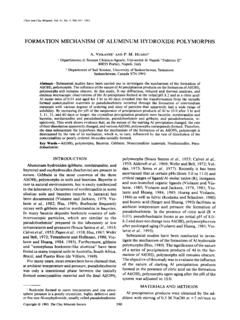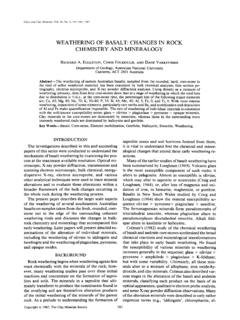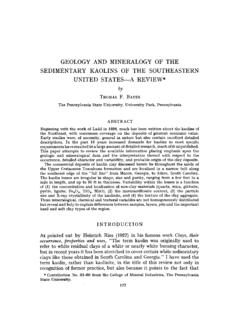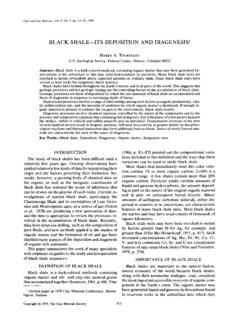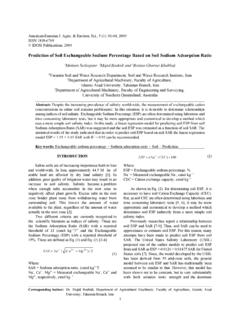Transcription of EFFECT OF CLAY MINERALOGY ON COEFFICIENT OF …
1 Clays and Clay Minerals, Vol. 46, No. 5, 596-600, 1998. E F F E C T OF CLAY M I N E R A L O G Y ON C O E F F I C I E N T. OF C O N S O L I D A T I O N. RETNAMONY G. R O B I N S O N AND M E H T E R M . A L L A M. Department of Civil Engineering, Indian Institute of Science, Bangalore-560 012, India Key Words--Clay MINERALOGY , COEFFICIENT of consolidation , COEFFICIENT of Volume Change, Consoli- dation, Diffuse Double Layer, Hydraulic Conductivity, Mechanical and Physicochemical Factors. INTRODUCTION erties of these minerals are reported in Table 2. Table The COEFFICIENT of consolidation (Cv) signifies the 3 reports the exchangeable cations present in the clay rate at which a saturated clay undergoes 1-dimensional minerals studied.
2 While the cations for kaolinite and consolidation when subjected to an increase in pres- illite are essentially divalent (73% and 93%, respec- sure. Measured in cm2/s, C~ is a function of hydraulic tively), the ratio of divalent to m o n o v a l e n t cations in conductivity, k (crn/s), COEFFICIENT of v o l u m e change, the case of montmorillonite is practically unity. mv (cm2/kg), and unit weight of pore fluid, ~w (kg/cm3), C o n v e n t i o n a l 1 - d i m e n s i o n a l c o n s o l i d a t i o n tests and is expressed as: were performed on 60-ram diameter and 2 0 - m m high soil specimens in the fixed-ring type consolidometer k as per A S T M D 2435-80 (1989).
3 The sides of the rings Cv - [1]. mv'Y~ were smeared with silicone grease to reduce side fric- tion. The samples of clay minerals were r e m o l d e d at Terzaghi and Peck (1967) anticipated that, with de- a water content of about times the liquid limit. For creasing v o i d ratio (increasing consolidation pressure, the powdered quartz, a remolding water content of p) both k and my decrease rapidly so that the ratio (k/. was used. A load increment ratio (ratio of in- my) and, hence, Cv, is fairly constant o v e r a wide range crease in pressure to the existing pressure) o f was of consolidation pressures.
4 The variation of Cv with adopted. The load was sustained sufficiently long to pressure has not r e c e i v e d m u c h attention in the past. ensure completion of primary consolidation (48 h for R e v i e w of s o m e available data in the literature on this montmorillonite in water and 24 h for all other tests). aspect, h o w e v e r shows that C~ is not constant (Table Falling head hydraulic conductivity tests were con- 1) but varies with consolidation pressure. An exami- ducted prior to application o f the next load increment. nation of Table 1 shows that Cv increases with con- consolidation and hydraulic conductivity tests were solidation pressure for kaolinite but decreases with also conducted on the powdered quartz as well as on consolidation pressure for montmorillonite (bentonite).
5 The clay minerals with CC14 as the pore fluid. The non- Both increasing and decreasing trends are observed polar pore fluid CC14 was adopted to suppress the in- (Table 1) for soils of unknown clay MINERALOGY . This fluence of exchangeable cations on the compressibility inconsistency in the variation of Cv with consolidation characteristics of the clay minerals (Olson and Mesri pressure for different soils (clays in particular) needs 1970). The minerals were m i x e d with CC14 to a slurry reconciliation. and were r e m o l d e d in the consolidation ring. Values The Cv-p trends obtained in the laboratory for the of Cv are derived from Equation [I].
6 Clay minerals kaolinite, illite and montmorillonite and p o w d e r e d quartz with water and C C I 4 a s pore fluids RESULTS AND DISCUSSION. are reported in this Note. These trends are evaluated relative to the mechanical and physicochemical factors Figure 1 shows the variation of k, mv and Cv with which are known to influence the compressibility be- consolidation pressure for the 3 clay minerals with wa- havior of clays (Olson and Mesri 1970; Sridharan and ter as the pore fluid. Similar plots for p o w d e r e d quartz Rao 1976). are shown in Figure 2. As expected, k and mv decrease with increase in consolidation pressure.
7 The ratio of k EXPERIMENTAL to mv (that is, Cv) is not constant over the pressure Three clay minerals (kaolinite, illite and montmo- range of interest, contrary to the prediction of Terzaghi rillonite) were used for the study. Ground quartz ( < 7 5 and Peck (1967). Further, the variation o f Cv with the Ixm) prepared f r o m Arkavathi R i v e r sand, was adopted consolidation pressure is dependent on the clay min- as a material w h o s e compressibility behavior is wholly eral type. There is a decrease of Cv with pressure in- g o v e r n e d by the elastic properties of the grains and by crease for montmorillonite and increases for kaolinite, the surface friction characteristics.
8 The physical prop- illite and powdered quartz. Copyright 9 1998, The Clay Minerals Society 596. Vol. 46, No. 5, 1998 EFFECT of clay MINERALOGY on Cv 597. Table 1. C~-pvariation in literature. Variation of Liquid Plasticity Cv with Source Soil type limit (%) Index (%) pressure Leonards and Ramiah (1959) Residual clay Decreases Glacial silty clay Increases Samarasinghe et al. (1982) Sandy clay Increases Don Valley clay Increases New Liskeard clay Increases Bentonite Decreases Kaolinite -- -- Increases Nakase et al. (1984) Kawasaki clay Increases Sridharan et al. (1994) Kaolinite Increases It can be seen from Table 3 that over 50% of the lic conductivity.
9 This is well understood to be due to exchangeable cations for the montmorillonite are Na, the dispersed fabric associated with water being re- while N a is less than 1% of the exchangeable cations placed by a structure o f particle aggregations that pos- for the illite. To see whether the type of cation (valen- sess larger effective pore sizes (Mesri and Olson cy) had any influence on the trend, experiments were 1971). Test results also showed that, in the pressure conducted on predominantly h o m o i o n i z e d clays. The range used, mv increased by about 30% of the original 3 clay minerals were washed 5 times with 1 N sodium value for kaolinite and decreased by about 33% for acetate solution to produce predominantly homoioni- illite and 20% for montmorillonite on changing the zed sodium clays.
10 To produce calcium clays, the clay pore fluid to CC14. Powdered quartz exhibited only a minerals were likewise washed with 2 N calcium chlo- times increase in hydraulic conductivity and no ride solution. The exchangeable cation concentrations significant change in rn v. Thus, the order of increase in these treated clays are indicated in Table 4. in Cv is practically related to the order of increase in The C~ versus consolidation pressure trend for these the hydraulic conductivity. h o m o i o n i z e d clays in water are presented in Figure 3. It is thus seen that, in the case o f montmorillonite, Irrespective o f the valency of the exchangeable cation, the trend o f C,,-p relationship depends on the type o f Cv increases with pressure for kaolinite and illite while pore fluid used but, for illite, kaolinite and p o w d e r e d it decreases for montmorillonite.

